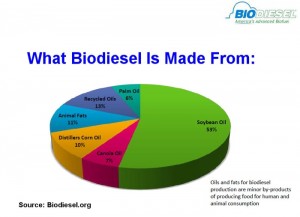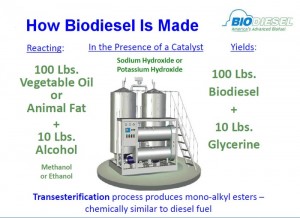Some people have a negative view of biodiesel. They say it gums up the fuel pump and injectors. They say it gels in cold weather. They say it’s diverting food resources to make fuel. They say it’s too expensive and can’t compete economically with conventional No. 2 diesel fuel.
Then they hear that diesel engines burning biodiesel are winning pulling championships, drag races and setting new land speed records. Maybe biodiesel isn’t so bad after all.
There’s a lot of misinformation and disinformation about biodiesel on the Internet. Truth is, it’s actually a good alternative fuel for diesel engines – provided the fuel meets the quality and performance requirements for the application. It can be blended with ordinary diesel fuel or burned straight. Biodiesel is being successfully used in everything from daily drivers to tow trucks to Class 8 semi-trucks, and for performance applications ranging from truck and tractor pullers to drag racers, road racers and even Bonneville speedsters.
There are a number of resources on the web providing detailed technical information about biodiesel. These websites have tons of info about biodiesel fuel characteristics, fuel quality standards, materials compatibility, lubricity benefits, fuel blending, and which automakers approve biodiesel in its vehicles. A list of association sites is included in this article.
The National Biodiesel Board represents the biodiesel industry and obviously promotes biodiesel as an alternative fuel for the benefit of its members. Even so, there are a lot of proponents of biodiesel who have nothing to do with producing, distributing or selling alternative fuels. These range from everyday consumers who drive diesel-power vehicles to professional racers who run 2500-plus horsepower diesel-powered trucks and tractors.
Greg Randall of the National Tractor Pullers Association said his organization began allowing B100 (a 100% straight blend of biodiesel) at its pulling events starting in 2013. The results were immediate. Pullers who were burning B100 were beating everybody else and winning events. Most pullers are secretive about their fuel mixtures because they know the right fuel blend can make more power and give them an edge over their competitors. “We used to test fuel mixtures to check for additives, but this year we are not requiring any fuel tests,” said Randall. The only requirement is that the fuel be some type of diesel derivative (conventional, synthetic or biodiesel) and that it does not contain oxygenators.
Bryce Anderson of the United Pullers of Minnesota says his organization has allowed biodiesel for the past couple of years. “We have seen no mechanical issues with fuel pumps or injectors.” But he did caution that straight B100 can damage rubber hoses so it’s important to use neoprene or silicon hoses and o-rings that are biodiesel compatible in the fuel system.” Other than that, no engine modifications are needed to burn biodiesel.
Anderson says B100 can make 6 to 10 percent more power than conventional diesel fuel, which translates into 100 to 200 more horsepower depending on the power level of the engine. He said B100 is winning national titles and setting world records because it is a better racing fuel than ordinary diesel. Competitors are using biodiesel in tractors, trucks and even semi-trucks at most events. And many of the spectators who attend these events are also using it on a daily basis in their own vehicles (typically B5 or B10 blend).
Anderson says that once somebody wins an event on B100, everybody else wants the same advantage. Those who aren’t taking advantage of what B100 has to offer are finding it harder and harder to remain competitive.
Back in 2011, a Hajek Motorsports Ford F-250 pickup truck powered by a 6.7L Powerstroke engine burning B20 biodiesel set a land speed record of 182 mph at Bonneville. This smashed the previous record of 167 mph, which had been held by a GMC Duramax.
Biodiesel can be made from a variety of plant oils including soybeans and corn oil. About half of the biodiesel that’s sold in the U.S is made from soybeans. It can also be made from recycled cooking oils or animal fats, including byproducts from chicken, pork and beef processing plants that would otherwise go to waste. It can even be made from algae. Running a diesel engine on soybean oil, recycled deep fat fryer grease or refined chicken guts may seem risky, but as long as the fuel meets quality standards, it’s safe to use. And in higher concentrations, it can provide a significant power gain.
Biodiesel usually requires no internal engine modifications or changes to the fuel delivery system. The engine’s compression ratio does not have to be changed. If an engine is running B100, it can usually handle some additional compression to maximize the cetane rating of the fuel (which can vary depending on what the fuel is made from). Biodiesel made from vegetable oils typically has a cetane rating of 46 to 52, while biodiesel made from animal fats has a higher rating of 56 to 60.
Low blends such as B5, B10 and even B20 burn pretty much the same as ordinary No. 2 diesel oil. However, straight B100 tends to be dirty at idle (produces more black smoke) – which usually doesn’t matter at a pulling event or drag race because fans like to see lots of black smoke.
The American Society of Testing Materials (ASTM) has quality standards for different blends of biodiesel, including ASTM D6751-12 for B100, ASTM D7467-13 for B6 to B20 blends, and ASTM D975 for B5 blends. According to ASTM, low-level blends such as B5 are approved for use in any compression-ignition diesel engine, including cars, light or heavy-duty trucks, marine or stationary engines.
B5 is commonly available in many areas of the country and is OEM approved for use in many diesel-powered vehicles. B20 is also a popular blend (20% biodiesel) and is used in many fleet applications. B20 may also be OEM approved for certain vehicles. Performance and fuel economy on B5 to B20 blends is similar to that on straight No. 2 diesel fuel. B100 actually contains less energy per gallon than ordinary diesel, but its higher cetane rating allows it to produce more power under high boost pressures.
American automakers typically require a minimum cetane rating of 40 for most engines, but European automakers typically specify a minimum cetane rating of 51.
A bit of history trivia worth mentioning here is that the very first diesel engine invented by Rudolph Diesel in 1893 ran on vegetable oil. So the case for biodiesel goes a long way back.
Biodiesel was originally promoted as a homegrown renewable alternative to expensive oil imported from offshore producers. Depending on crop prices and world oil prices, biodiesel can compete economically with conventional diesel fuel. It also burns cleaner than diesel fuel, reducing greenhouse gas emissions. And as truck and tractor pullers have discovered, it can also make more power and win events.
Today, however, the economics is more challenging. In recent months, Saudi Arabia has been flooding the world market with crude oil to drive down oil prices. Oil that used to sell for over $100 a barrel has been selling as low as $48 a barrel, and is currently bouncing around $54 to $58 a barrel. Although low oil prices mean less cash flow into Saudi coffers (which are already stuffed with mega billions of dollars), it also means U.S. shale oil producers and biodiesel producers are finding it harder to compete with cheap Saudi oil. Crude oil prices generally have to be above $60 a barrel for many alternative fuel sources to remain profitable.
Currently, the U.S biodiesel industry has the capacity to produce almost 2 billion gallons of biodiesel a year. However, the U.S. Energy Information Administration reported that in 2014, only 1.27 billion gallons of biodiesel were produced, which was down from a peak of 1.36 billion gallons in 2013 – which means there is a lot of excess capacity in the biodiesel industry that is not being used.
The Federal Renewable Fuel Standard (RFS), which came about as part of the Energy Policy Act of 2005, requires oil companies to blend a certain amount of biodiesel and ethanol into diesel and gasoline for the purpose of extending domestic fuel supplies, reducing our dependence on foreign oil and for reducing emissions. Big Oil hates the RFS requirements because it cuts into its profits, and it’s been fighting hard to kill it. In the meantime, the Feds have been dragging their feet on setting the amount of biofuel that’s required for 2014 (which is already past history) and for 2015 and beyond. The biodiesel producers are hoping the numbers will increase so they can utilize more capacity, while Big Oil is pushing for smaller numbers or to eliminate the requirements altogether.
So how does all of this affect engine builders? Building performance diesel engines is pretty much a niche rather than a broad market opportunity. Although the basics of building a performance engine to run on gasoline is similar to that of building a performance engine to run on diesel, there are a lot of differences that require experience and know-how to compete successfully in highly competitive events.
Biodiesel is just part of the equation to making as much power as possible in both stock and highly modified engines. The bottom line is if you can build a competitive engine that runs on conventional diesel fuel, you can also build an even more competitive engine that will run on B100 biodiesel.
Another article in this issue discusses the upgrades in the crankshaft, connecting rods and pistons that are usually necessary when producing big horsepower numbers. So whether the fuel is conventional diesel or biodiesel, the basics inside the engine remain the same.

